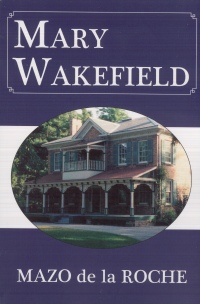| ________________
CM . . . . Volume XVII Number 10. . . .November 5, 2010. 
 |
Mary Wakefield.
Mazo de la Roche.
Toronto, ON: Dundurn Press, 1949/2009.
316 pp., pbk., $24.99.
ISBN 978-1-55002-877-5.
Grades 10 and up / Ages 15 and up.
Review by J. Lynn Fraser.
**½/4
|
| |
|

excerpt:
Gothic vampire romance in fiction, television and in movies is currently in vogue. Readers of Mazo de la Roche’s Mary Wakefield, the author’s third foray into the “Whiteoaks of Jalna” series, will recognize themes reminiscent to that of the Twilight Saga’s forbidden love, intertwined blood lines, romance, as well as jealousy and overblown gothic and melodramatic scenes, as seen in this example:
Adeline’s heart cried out, “My darling, oh, my darling!” For one blind instant she felt that she would throw herself on the grave, pressing it to her breast, as she had pressed him when he lay dying.
Interpreted from that perspective, this novel, originally written in 1949 and an exemplar of Southern Ontario Gothic fiction, may take on a new relevance for teenaged readers and adult lovers of “vamp-romance.”
While the prose in the novel is florid and “humid,” it does present opportunities for young readers to learn various literary devices through the author’s heavy-handed prose. For example, similarly to the Brontë sisters, architecture is rendered anthropomorphically:
She drew a deep breath of nervous tension. All the rooms in the house were alive now, conscious of her, antagonistic to her.
Mazo de la Roche’s “Whiteoaks of Jalna” series, and Mary Wakefield in particular, are ripe for parody as seen in the recent novels Pride and Prejudice and Zombies and Sense and Sensibility and Seamonsters. Such parodies draw attention to the elements involved in creating fiction, such as narrative, dialogue, scene setting, leitmotifs, and the conventions of different genres being brought together. This would be a modern approach to teaching de la Roche’s novels and keeping them relevant to teenaged readers.
Class issues, social propriety, as well as the role of women in society, also important elements in the Brontë sisters work, are described in this novel:
Adeline blew out her breath. “Well, well,” she said. “Quite a forward young woman.”
Forward! Forward’s no name for her behaviour. Twice this week she’s gone through the house singing. Just as though she was mistress here!
Interestingly, the current economic downturn is echoed in the novel wherein a character has lost money due to bad investments and buying on credit:
He had lost money in Crystal Palace A shares. He had lost money in Breweries. He had lost money in Cotton. He had been fooled by a broker into buying shares on margin. More and more good money had been thrown away to retain his shares. He was indeed playing with capital that was not his.
The role of women and the role of money and materialism in the novel offer an interesting point of comparison for younger readers in the classroom.
The novel Mary Wakefield would have a limited appeal to most readers. If approached from the perspectives outlined above and with creativity, the novel might have relevance for discussions on Ontario and Canadian social history, economics, genre in literature, as well as the techniques and conventions of writing.
Recommended with reservations.
Located in Toronto, ON, J. Lynn Fraser is an author and freelance writer. She writes for national and international magazines, non-profits, and corporations.

To comment on this title or this review, send mail to
cm@umanitoba.ca.
Copyright © the Manitoba Library Association. Reproduction for personal use is permitted only if this copyright notice is maintained. Any other reproduction is prohibited without permission.
NEXT REVIEW |
TABLE OF CONTENTS FOR THIS ISSUE- November 5, 2010.
AUTHORS |
TITLES |
MEDIA REVIEWS |
PROFILES |
BACK ISSUES |
SEARCH |
CMARCHIVE |
HOME |
